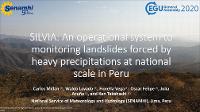SILVIA: An operational system to monitoring landslides forced by heavy precipitations at national scale in Peru
Autor(es)
Fecha
2020Palabras clave
Precipitación - Fenómenos Meteorológicos - Hidrometeorología - Huaycos - Andes - Evaluación de Riesgos - Deslizamiento de TierrasColecciones
- Congreso [32]
Recurso(s) relacionado(s)
https://meetingorganizer.copernicus.org/EGU2020/EGU2020-10970.htmlResumen
In Peru, heavy precipitations (PR) are the second natural phenomenon with the greatest number of people affected in recent decades. Landslides (known as “huaycos” in Peru) are mostly produced by PR and located overall on the Andes mountains. In this regard, to monitoring and inform in advance about the most susceptible regions to landslides, the National Service of Meteorology and Hydrology of Peru (SENAMHI) has launched the national system for monitoring of landslides produced by PR, called SILVIA (“Sistema de Monitoreo de Movimientos en Masa generados por Lluvias Intensas” in spanish).
The methodology couple PR thresholds (7 days of antecedent PR) from PISCO operational precipitation (a gridded daily precipitation product of SENAMHI) with the susceptibility map for landslide hazard produced by the Peruvian Geological, Mining and Metallurgical Institute (INGEMMET). Both inputs products are combined in a purposely-built hazard matrix to get a
spatially and temporally variable for landslide hazard: while statistical PR thresholds are used to accomplish a temporal definition with very coarse spatial resolution, landslide susceptibility maps provide static spatial information about the probability of landslide occurrence at fine spatial resolution. The hazard matrix combines three susceptibility classes (S1, low susceptibility; S2
medium susceptibility; S3 high and very high susceptibility) and three PR rate classes (L1, L2, L3), defining three hazard classes, from P1 (low hazard) to P3 (high hazard).
El ítem tiene asociados los siguientes ficheros de licencia:








